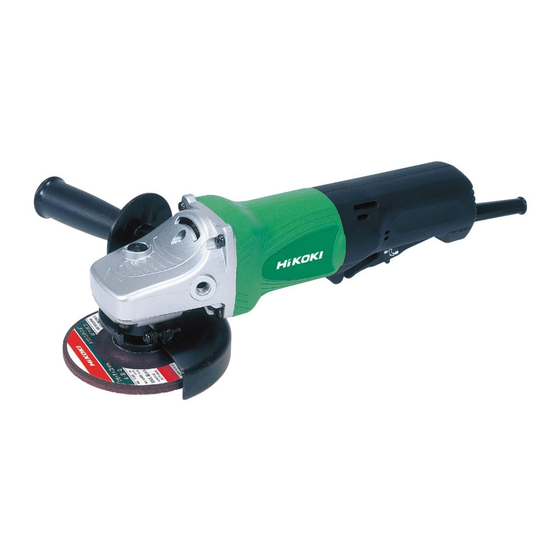HIKOKI G 12SE2 Handling Instructies Handleiding - Pagina 8
Blader online of download pdf Handling Instructies Handleiding voor {categorie_naam} HIKOKI G 12SE2. HIKOKI G 12SE2 20 pagina's.

English
3. To prevent a new depressed center wheel from digging
into the workpiece, initial grinding should be performed
by drawing the grinder across the workpiece toward the
operator (Fig. 3 direction B). Once the leading edge
of the depressed center wheel is properly abraded,
grinding may be conducted in either direction.
4. Switch operation
[When the switch has locking mechanism]
Switch ON: To switch on, slide the lock lever in the
direction of Ⓐ and press the paddle
lever in the direction of Ⓑ as shown in
Fig. 4-a.
Furthermore, slide the lock lever in the
direction of Ⓒ shown in Fig. 4-b while
pressing the paddle lever to lock and
enable continuous operation.
Switch OFF: To release the locking mode, press
the paddle lever in the direction of Ⓑ
shown in Fig. 4-a, and release the
paddle lever to switch off .
[When the switch has no locking mechanism]
To switch on, slide the lock lever in the direction of Ⓐ
and press the paddle lever in the direction of Ⓑ as
shown in Fig. 4-a. Release the paddle lever to switch
off .
NOTE
The paddle lever can not be locked.
5. Precautions immediately after fi nishing operation
The wheel continues to rotate after the tool is switched
off .
After switching off the machine, do not put it down until
the depressed center wheel has come to a complete
stop. Apart from avoiding serious accidents, this
precaution will reduce the amount of dust and swarf
sucked into the machine.
CAUTIONS
○ Check that the work piece is properly supported.
○ Ensure that ventilation openings are kept clear when
working in dusty conditions.
If it should become necessary to clear dust, fi rst
disconnect the tool from the mains supply (use non-
metallic objects) and avoid damaging internal parts.
○ Ensure that sparks resulting from use do not create
a hazard e.g. do not hit persons, or ignite fl ammable
substances.
○ Always use protective safety glasses and hearing
protectors, use other personal protective equipment
such as gloves, apron and helmet when necessary.
○ Always use eye and ear protection.
Other personal protective equipment such as dust
mask, gloves, helmet and apron should be worn when
necessary.
If in doubt, wear the protective equipment.
○ When the machine is not use, the power source should
be disconnected.
ASSEMBLING AND DISASSEMBLING THE
DEPRESSED CENTER WHEEL (Fig. 1)
CAUTION
Be sure to switch OFF and disconnect the attachment
plug from the receptacle to avoid a serious accident.
1. Assembling (Fig. 1)
(1) Turn the disc grinder upsidedown so that the spindle is
facing upward.
8
(2) Align the across fl ats of the wheel washer with the
notched part of the spindle, then attach them.
(3) Fit the protuberance of the depressed center wheel
onto the wheel washer.
(4) Screw the wheel nut onto the spindle.
(5) While pushing the push button with one hand, lock the
spindle by turning the depressed center wheel slowly
with the other hand.
Tighten the wheel nut by using the supplied wrench as
shown in Fig. 1.
2. Disassembling
Follow the above procedures in reverse.
CAUTIONS
○ Comfi rm that the depressed center wheel is mounted
fi rmly.
○ Confi rm that the push button is disengaged by pushing
push button two or three times before switching the
power tool on.
MAINTENANCE AND INSPECTION
1. Inspecting the depressed center wheel
Ensure that the depressed center wheel is free of
cracks and surface defects.
2. Inspecting the mounting screws
Regularly inspect all mounting screws and ensure that
they are properly tightened. Should any of the screws
be loose, retighten them immediately. Failure to do so
could result in serious hazard.
3. Inspecting the carbon brushes (Fig. 5)
The Motor employs carbon brushes which are
consumable parts. When they become worn to
or near the "wear limit", it could result in motor
trouble. When an auto-stop carbon brush is equipped,
the motor will stop automatically. At that time, replace
both carbon brushes with new ones which have the
same carbon brush Numbers shown in the fi gure.
In addition, always keep carbon brushes clean and
ensure that they slide freely within the brush holders.
4. Replacing carbon brushes (Fig. 6)
<Disassembly>
(1) Loosen the D4 tapping screw retaining the tail cover
and remove the tail cover.
(2) Use the auxiliary hexagonal wrench or small screwdriver
to pull up the edge of the spring that is holding down the
carbon brush. Remove the edge of the spring toward
the outside of the brush holder.
(3) Remove the end of the pig-tail on the carbon brush from
the terminal section of brush holder and then remove
the carbon brush form the brush holder.
<Assembly>
(1) Insert the end of the pig-tail of the carbon brush in the
terminal section of brush holder.
(2) Insert the carbon brush in the brush holder.
(3) Use the auxiliary hexagonal wrench or small screwdriver
to return the edge of the spring to the head of the carbon
brush.
(4) Mount the tail cover and tighten the D4 tapping screw.
5. Maintenance of the motor
The motor unit winding is the very "heart" of the power
tool. Exercise due care to ensure the winding does not
become damaged and/or wet with oil or water.
6. Service parts list
A: Item No.
B: Code No.
C: No. Used
D: Remarks
